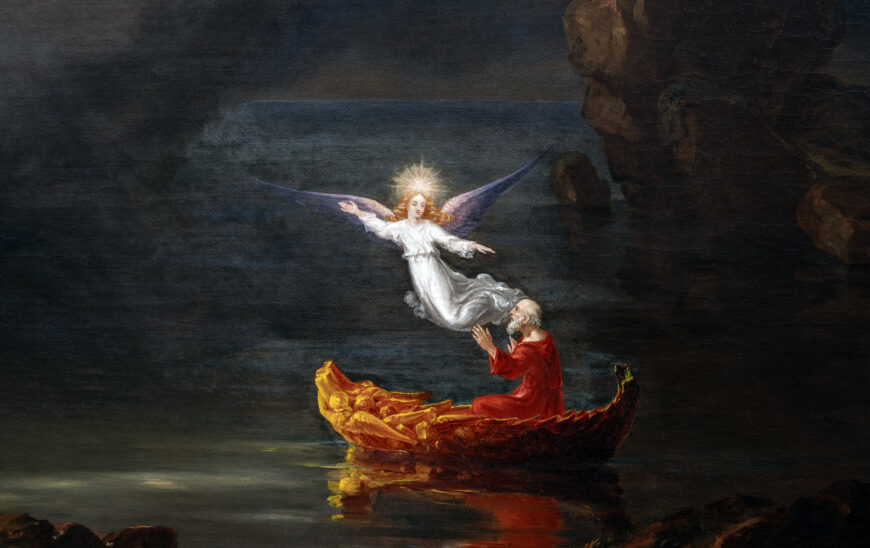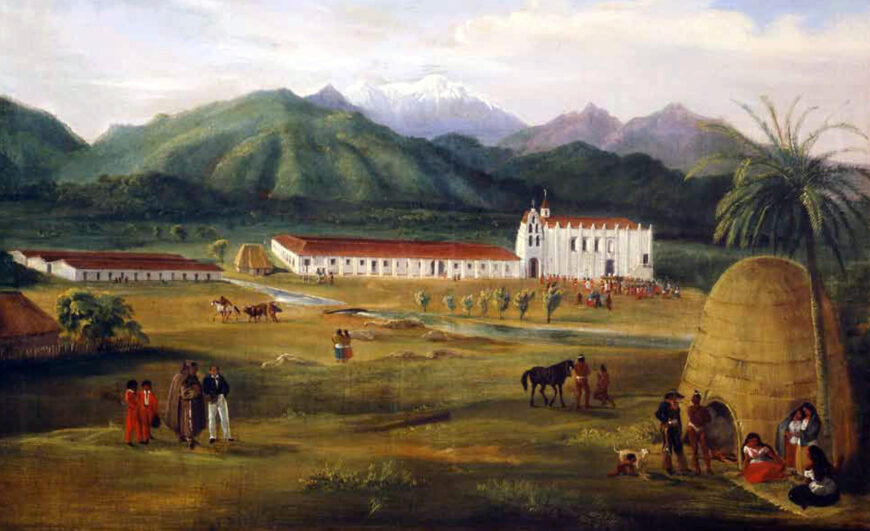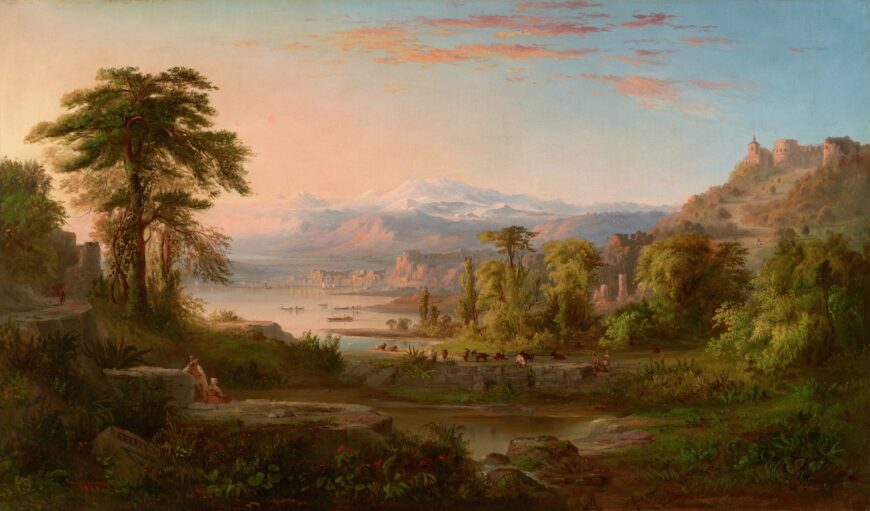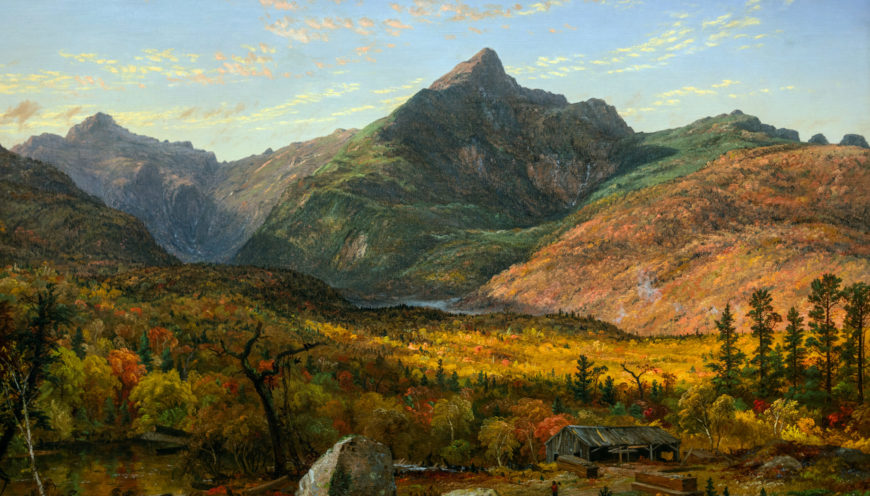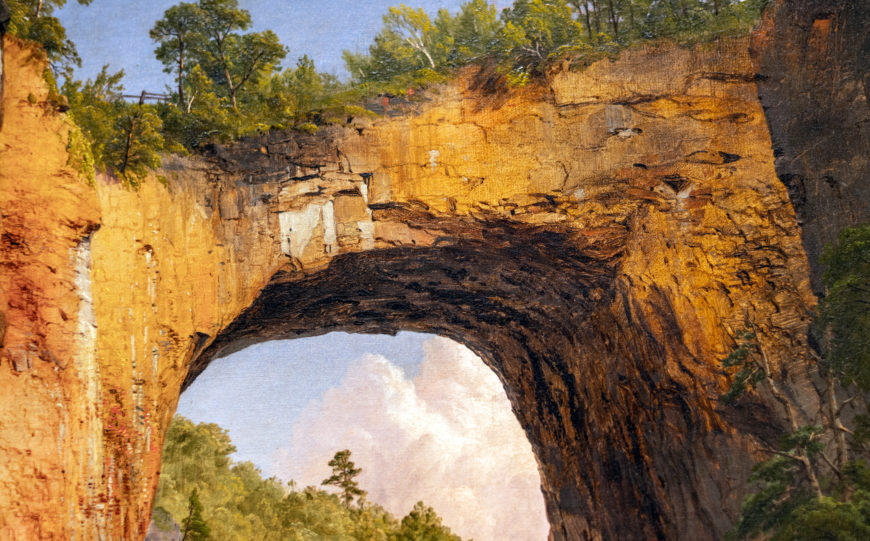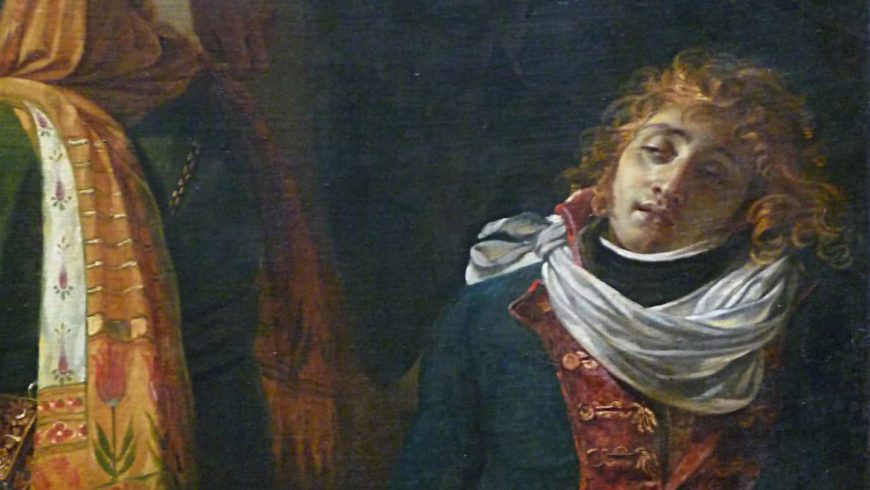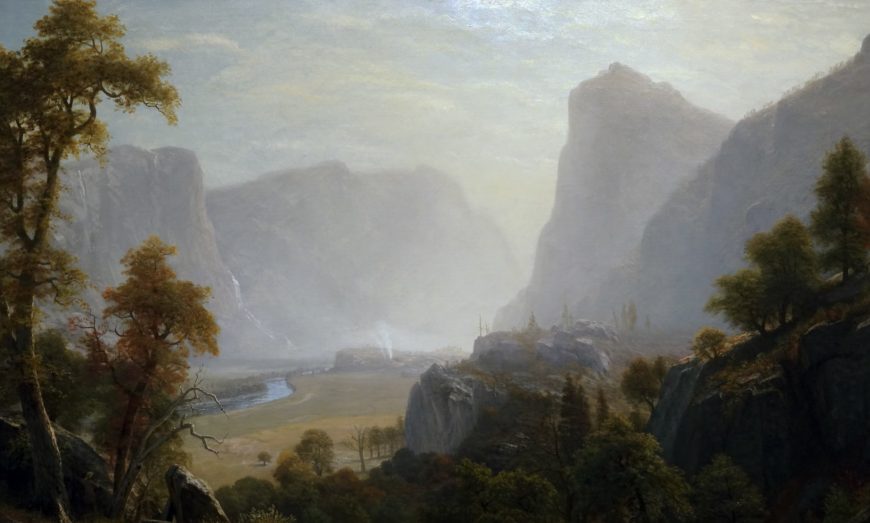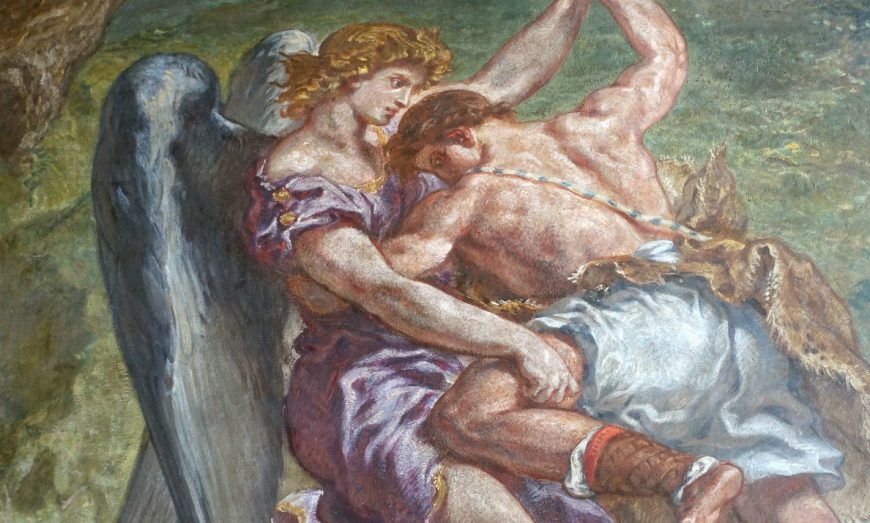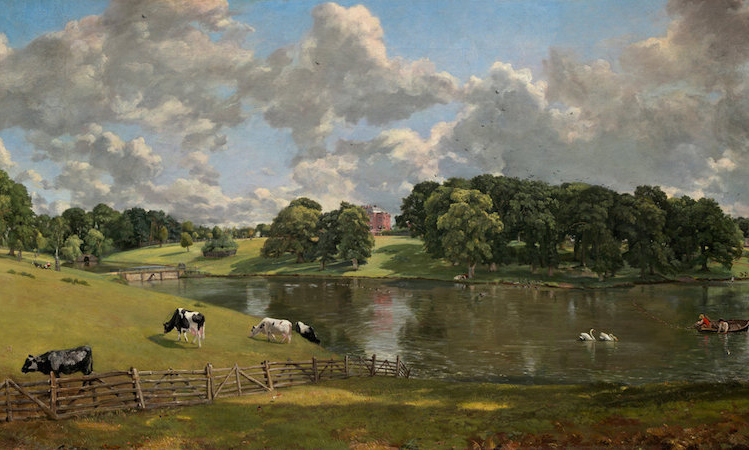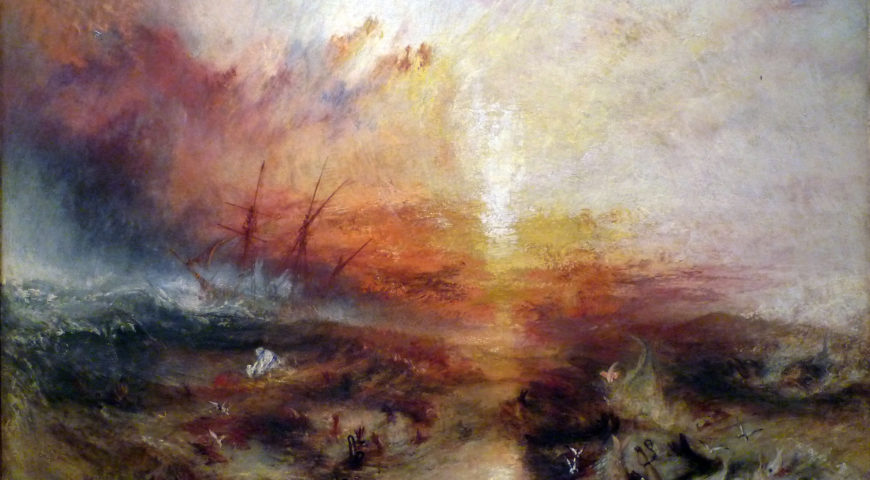Emanuel Leutze, Washington Crossing the Delaware,1851, oil on canvas, 379 x 648 cm (The Metropolitan Museum of Art)
[0:00] [music]
Dr. Beth Harris: [0:04] We’re standing in a lovely skylit room in the Metropolitan Museum of Art, looking at a very famous painting, but we’re actually going to try a different method today. We’re going to not talk about our assumptions about what we’re seeing, but we’re going to take the time to look closely.
Dr. Steven Zucker: [0:20] We’re standing with Sarah Alvarez, who’s Director of School Programs at the Art Institute of Chicago. She’s going to help us with this process.
Sarah Alvarez: [0:28] I’d like for us to talk about some of the things that caught our attention when we first looked at this. It might be a feeling we had, it might be a particular detail in the painting.
Dr. Harris: [0:38] Well, given that it’s a cold January day, I immediately empathized with the very cold, windy weather.
Dr. Zucker: [0:46] What strikes me first is just the sheer size of this canvas. This was painted with a paintbrush. It must have taken forever.
Sarah: [0:55] We might want to take your observation and pose it as a question to ourselves. How was this made? What were the materials that were used? How long did it take? Those are questions that we can continue to explore, and we should make an inventory as we’re talking about some of those things we’re wondering about.
Dr. Zucker: [1:09] Asking those questions prompted me to ask another question, which is why it’s so big. This could never fit in my house. Where was this intended to be?
Sarah: [1:18] We see a large number of figures packed into boats. Based on the way that they’re all faced and other actions that we can see them making, they all seem to be moving in the same direction across a body of water.
[1:30] There’s a tall figure in the boat that’s in the foreground that is very determined-looking. Is he the leader? Is he the most important? How is he related to all of these other figures?
Dr. Harris: [1:40] I also notice that the figures seem wrapped up in their own worlds.
Dr. Zucker: [1:44] I’m noticing how distinct each one is from the other. They’re wearing different clothing. They’re not only in their own worlds, but they seem to come out of different worlds.
Sarah: [1:54] I’m wondering, where is this frozen, cold place? There’s these cloudy skies. Maybe that’s a star, maybe that’s the sun that is poking through the clouds.
Dr. Zucker: [2:04] I’m struck that the standing figure and the figure holding the flag seem immune to that cold. They seem so focused, so determined, so resolute, looking towards that far shore. The cold seems to pass over them.
Dr. Harris: [2:18] There’s also a sense of chaos around them.
Dr. Zucker: [2:21] It is really interesting how there is simultaneously both a frenetic energy and a sense of stillness and quiet. My eye keeps going back to that central figure. That’s the only face that’s not obscured, that’s in profile, and it’s illuminated by the sky behind it.
Dr. Harris: [2:38] And around him are all of these diagonal lines. And all of those diagonal lines point to the right, and yet we know the boat is moving to the left.
Dr. Zucker: [2:48] At the same time, those oars and that flagpole mark a kind of area that that central figure can inhabit and emphasize his importance even more.
Sarah: [2:58] One question is, are there other images in our mind, in our visual reference bank, that tell us that this is a person of importance?
Dr. Harris: [3:05] He looks like a profile of a figure on a coin.
Dr. Zucker: [3:08] The lighting reminds me of religious images. It reminds me of images where biblical events are unfolding.
Sarah: [3:14] We’ve talked a lot about the choices the artist has made to position the figures, the boat, the land, but there are some other even more fundamental characteristics of this painting, like the colors and the brushstrokes, that might be helpful for us to explore in order to generate some additional questions.
Dr. Zucker: [3:30] The things that are part of the natural world are cool — blues, and whites, and greens; and the boat, the things that are man-made, and the people and their clothing, tend to be warmer colors.
Sarah: [3:43] It’s almost as if there are layers of different kinds of tension that the artist has chosen to use in this painting.
Dr. Harris: [3:50] This event is unfolding before us. Everyone except for that central figure is in the middle of moving.
Sarah: [3:55] If you look very closely, every single line and brushstroke is so precise, and they feel so still, yet there’s so much animation to a lot of the details — again, another point of tension.
Dr. Harris: [4:09] It’s like the artist wants us to notice those little details, too. The bag, it looks like a bag that I’ve seen in galleries of Native American art. Or the fur caps, these details of clothing that seem to differentiate the figures and draw us in to look at them.
Dr. Zucker: [4:26] It is remarkable how long this painting holds my attention. It does make me wonder whether or not it was designed to make a large, powerful impact initially, but then to draw me in to these little details.
Sarah: [4:39] Let’s gather together the questions that we’ve posed. We’ve asked about the artist’s intentions, the choices that the artist made, whether it be in the scale of the painting, the composition.
[4:50] We’ve asked a lot of questions about what’s happening here. Who was meant to see this? Where was it meant to go? We have a lot of questions about the making of the painting and the initial reception of the painting.
[5:02] We might also ask questions about when it was made, and how people have thought about it or experienced it since then. One of the important steps in our process is to think about what sources we use.
[5:14] We have documentation from the popular press that tells us about how people were engaging with the painting, what they saw, what they thought. We also have other kinds of materials, like prints, or keepsakes that were produced in vast quantities and distributed all over the country.
[5:31] All of these primary sources give us further information about this moment in time and the meaning of this painting. Let’s just simply start with the title and date.
Dr. Harris: [5:43] “Washington Crossing the Delaware.” It’s so tempting to say this was 1776, which is the date of the Declaration of Independence and the year that Washington crossed the Delaware, but this was actually made 75 years later.
Sarah: [5:58] What do we know about the subject?
Dr. Harris: [6:01] Well, we know that this was an important turning point in the revolution. That Washington and his troops had lost several major battles to the British. The troops were disheartened, they were tired, there was a sense of hopelessness, and that this battle and the victory that followed changed the outlook of the revolutionaries and gave them hope for the future.
Dr. Zucker: [6:24] Washington’s troops were crossing the Delaware in order to mount a sneak attack in the middle of the night against Hessian soldiers fighting on behalf of the British — that is, Germans. Leutze had been born in Germany. He had grown up in the United States but he had gone back, and he painted this in the German city of Dusseldorf.
Sarah: [6:42] So what was happening in 1851 that might help us understand why Leutze decided to portray this subject at this time?
Dr. Harris: [6:50] We know that there was a series of revolutions in Europe in 1848. There was a desire to overturn an old order of kings and emperors and create a new order where people had more say in their government.
Sarah: [7:06] All of the different places where revolutions were happening essentially failed. There were many different groups of revolutionaries who could not unify to succeed in their efforts. We know that Emanuel Leutze was sympathetic to this revolutionary cause and a painting like this would provide hope.
Dr. Harris: [7:24] We have George Washington leading the troops, but the time that the artist has spent on all the other individual figures and their clear differences makes me think about how revolutions are made up of people of different backgrounds coming together to fight for a single cause.
Sarah: [7:44] It also suggests that a revolution is tenuous, that the success of the revolution is contingent upon the unity of diverse voices.
[7:54] This is the 50th anniversary of the death of George Washington in 1851. People are celebrating him as the great unifier of this young nation. There’s also a moment in the United States at this time where even though unity exists, there’s still a fractured nation. There’s sectionalism, especially around the issue of slavery. And an image like this suggests that unity is possible.
Dr. Zucker: [8:19] The reports are that the crowds were enormous, that people flocked to see this painting.
Dr. Harris: [8:24] It offered them an image of unity in the face of incredible sectionalism in the United States in the 1850s.
Sarah: [8:32] In December 12th of 1851, a notice in the “New York Daily Times” said that over 20,000 people have visited the exhibition. “The sight of such a splendid work of art will do more for the union of this country than a thousand union speeches.”
[8:47] Another notice in the “Albion” said that “We defy anyone possessed of one grain of sensibility to look upon it unmoved,” referencing the emotional power of this painting.
Dr. Harris: [8:59] For Americans in the mid-19th century, Washington himself, but also the Revolutionary War, it was this defining moment of American character that we together defeated the British.
Sarah: [9:12] Artists like Robert Colescott, Jacob Lawrence, and others have reproduced this image and told very different stories of American history.
Dr. Zucker: [9:20] And that’s a reminder that a work of art is always a product of its own time and is itself a primary source.
Sarah: [9:28] And works of art do something really wonderful, which is that they play on our emotions, they pull at our senses, and they captivate us in a way that drives our sense of curiosity and gets us to ask questions that allow us to approach history in deeper and richer ways.
[9:45] [music]
An American icon (made in Germany)
Washington Crossing the Delaware is one of the most recognizable images in the history of American art. You might be surprised, however, to learn that it was not painted by an American artist at work in the United States, but was instead completed by Emanuel Leutze, an artist born in Germany, and that it was painted in Düsseldorf during the middle of the nineteenth century.
Leutze painted two versions of this painting. He began the first in 1849 immediately following the failure of Germany’s own revolution. This initial canvas was eventually destroyed during an Allied bombing raid in World War II. The artist began the second version of Washington Crossing the Delaware in 1850. This later painting was transported to New York where it was exhibited in a gallery in October 1851. Two years later, Marshall O. Roberts, a wealthy capitalist, purchased the work for the then-staggering price of $10,000. It was donated to the Metropolitan Museum of Art in 1897. It remained there until 1950 when long held curatorial concerns about its bombastic, crowd-pleasing qualities led the museum to send it to Dallas and eventually to a site near the actual river crossing. The painting returned to New York in 1970.

Washington (detail), Emanuel Leutze, Washington Crossing the Delaware, 1851, oil on canvas, 378.5 x 647.7 cm (Metropolitan Museum of Art, photo: Steven Zucker, CC BY-NC-SA 2.0)
Although Emanuel Leutze was born in Schwäbisch Gmünd, Germany, his family immigrated to the United States before he turned ten years of age. His first art instruction came in 1834 when he studied drawing and portraiture with John Rubens Smith, a London-born artist who worked in the United States during the first half of the 19th Century. Wealthy Philadelphian patrons recognized Leutze’s talent and sponsored the young artist to study at the Königliche Kunstacademie in Düsseldorf. While there, Leutze came to know many American artists who were then studying in Germany. These artists included Worthington Whittredge, Albert Bierstadt, Charles Wilmar, and Eastman Johnson.
Although he was active in portraiture, Leutze’s fame today rests upon his history paintings, and among these, Washington Crossing the Delaware is the most recognizable and ambitious. It is, in one word, colossal, both in scale and patriotic zeal.
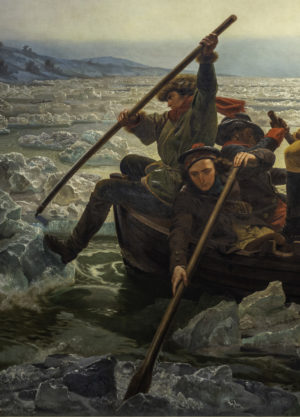
Rowers breaking up the ice as they cross the river on Christmas Day (detail), Emanuel Leutze, Washington Crossing the Delaware, 1851, oil on canvas, 378.5 x 647.7 cm (Metropolitan Museum of Art, photo: Steven Zucker, CC BY-NC-SA 2.0)
Brilliance and desperation on a vast scale
Little can prepare a viewer for the experience of standing before a painting that measures more than 12 x 21 feet. The monumental scale of the composition is matched by the importance of the historical event Leutze painted. Without doubt, Leutze took his subject from one of the turning points in the American Revolutionary War.
The Colonial cause appeared exceptionally bleak as the year 1776 came to a close. In a military move that navigated the fine line between brilliance and desperation, George Washington led the Colonial army across the Delaware River shortly after nightfall on 25 December in order to attack the Hessian encampment outside Trenton, New Jersey. Washington and his army achieved an unprecedented tactical surprise and delivered a much-needed military and moral victory. Washington’s army killed 22 Hessian soldiers, wounded 98 more, and captured more than 1,000 (Hessians were Germans soldiers hired by the British Empire). The Colonial Army had less than ten combined dead and wounded soldiers. After many military setbacks in the North, Washington’s bold move on Christmas night 1776 helped provide a sense of hope for the Colonial cause.
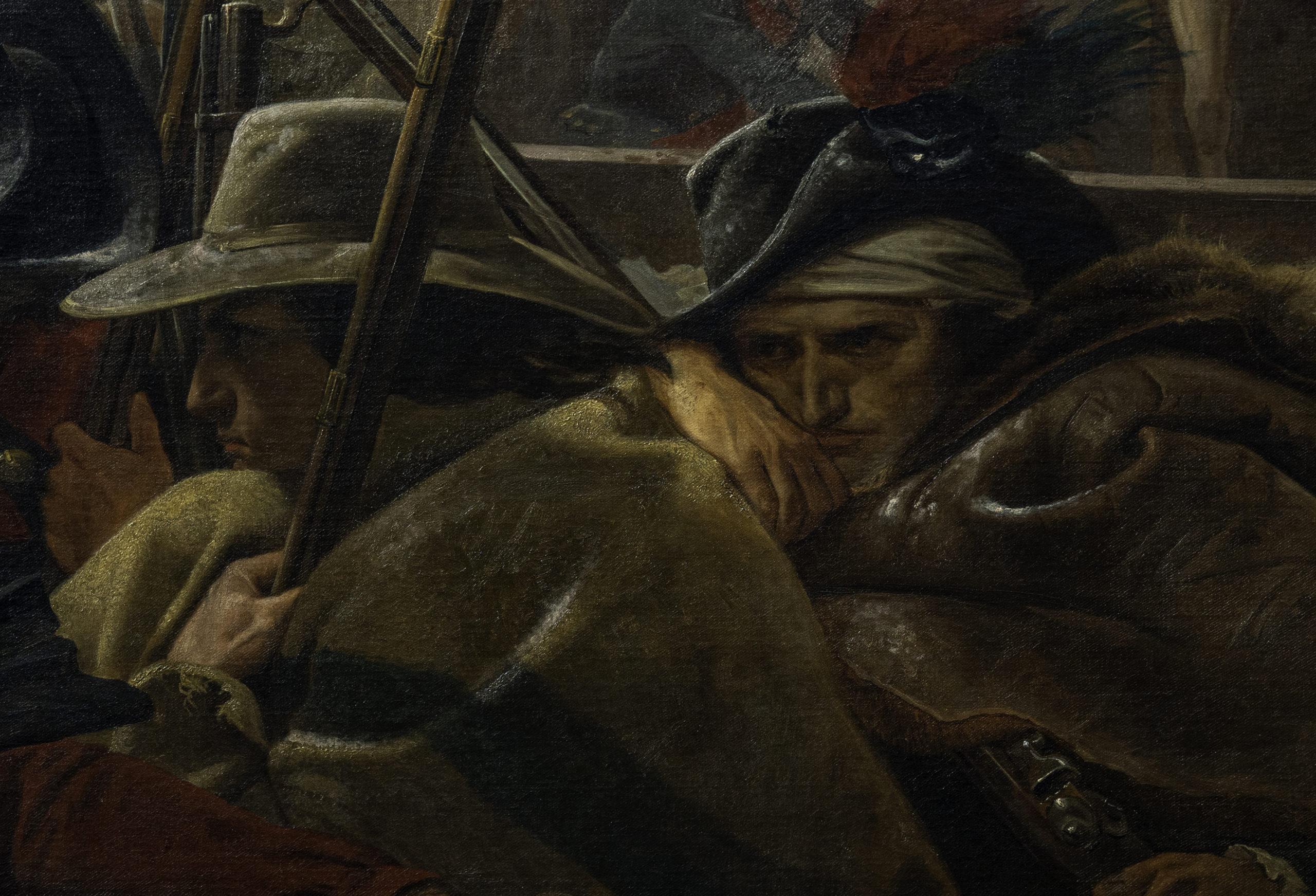
Farmers huddled against cold at middle of boat (detail) Emanuel Leutze, Washington Crossing the Delaware, 1851, oil on canvas, 378.5 x 647.7 cm (Metropolitan Museum of Art, photo: Steven Zucker, CC BY-NC-SA 2.0)
In addition to General Washington, Leutze has filled the boat with a variety of ‘types’ of soldiers. Washington and his two officers are distinguished by their blue coats, the trademark attire of a Continental officer.
The remaining nine men appear to be members of the militia. Three men row at the bow of the boat. One is an African American, another wears the checkerboard bonnet of a Scotsman, and the third wears a coonskin cap.
Two farmers, distinguished by their broad-brimmed hats, huddle against the frigid cold in the middle of the boat, while the man at the stern wears the moccasins, pants, and hat of a Native American. This collection of people suggests the all-inclusive nature of the Colonial cause in the American Revolutionary War.
Poetic license
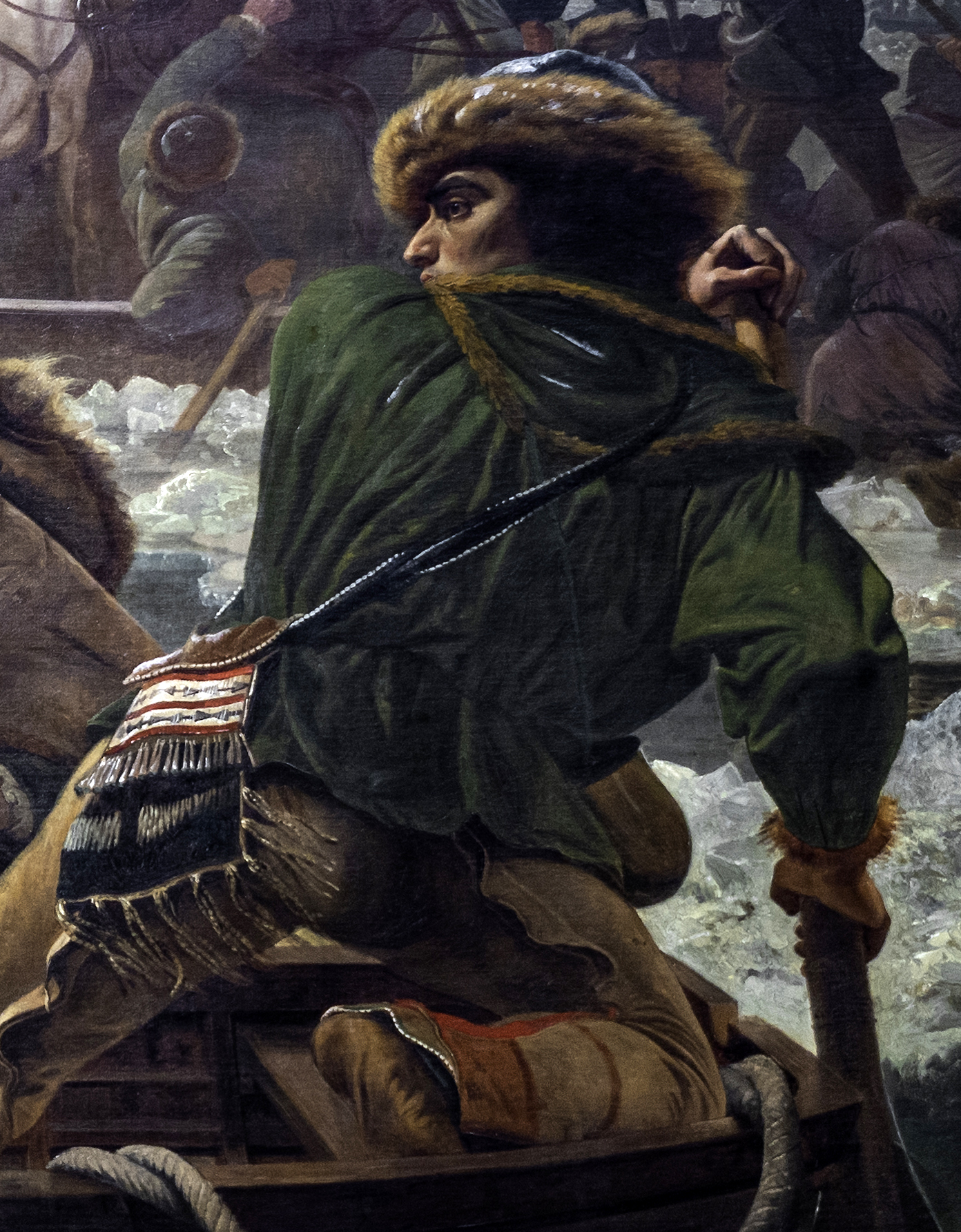
Native American at back of boat (detail), Emanuel Leutze, Washington Crossing the Delaware, 1851, oil on canvas, 378.5 x 647.7 cm (Metropolitan Museum of Art, photo: Steven Zucker, CC BY-NC-SA 2.0)
Despite Leutze’s interest in history, there is little historical accuracy to be found within the painting. First, the “Stars and Stripes” flag shown in the painting was not in use until September 1777, and the size of the boat is far too small to accommodate the twelve men who occupy it.
And although this event happened in the middle of the night, Leutze shows the crossing occurring at the break of dawn. Rather than depict the Delaware River, a waterway that was rather narrow where Washington and the Continental Army crossed, Leutze paints what appears to be a river with the breadth and ice formation of the Rhine. Finally, and perhaps most interestingly, Leuzte paints Washington standing upright, an unlikely and precarious posture for anyone in a short-walled rowboat.
It is clear then that Washington Crossing the Delaware‘s strength is not in the correct rendering of an historical event. Leutze’s primary goal was to create a work of art that deliberately glorified General Washington, the Colonial-American cause, and commemorated a military action of particular significance. In doing so, Leutze created one of the most iconic images in the history of American art.


